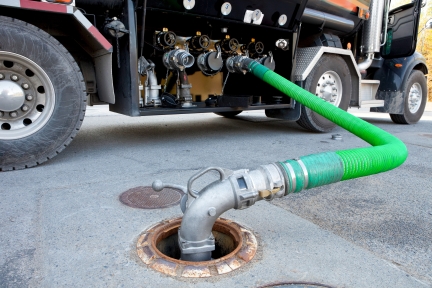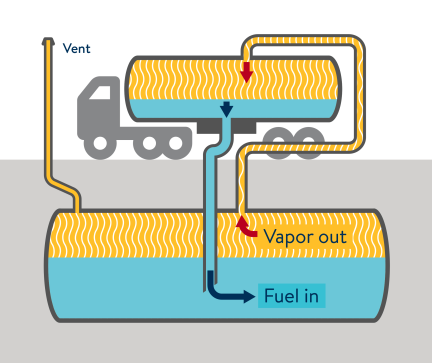
Ground-level ozone, unlike other pollutants, is not emitted directly into the atmosphere by a particular source. It is formed when volatile organic compounds (VOCs) chemically react with nitrogen oxides (NOx). Sunlight and heat stimulate the process and therefore the highest levels of ozone occur in the summer months. Gasoline vapors contain VOCs that contribute to the formation of ground-level ozone. In addition, gasoline vapors contain many other toxic substances, including benzene, a known carcinogen. In 2014 alone, gasoline service stations throughout Minnesota accounted for 10.7 million pounds of VOC emissions.
Stage 1 vapor recovery systems

A Stage 1 vapor recovery system captures vapors that are released when gasoline is delivered to a storage tank, significantly reducing the amount of VOCs released to the air. Vapors are returned to the tank truck as the storage tank is being filled with fuel, then returned to the bulk-dispensing terminal where they are either recycled or destroyed.
Dual point configurations have two separate tank openings: one for delivery of the product and the other for the release of vapors.
Coaxial systems require only one tank opening. This is the method to retrofit existing tanks with vapor recovery systems. The tank opening is usually four inches in diameter with a three-inch product fill tube inserted into the opening. Fuel flows through the inner tube while vapors are displaced through the annular space between the inner and outer tubes.
Ask your tank contractor about the most cost-effective option for your facility.
Benefits
Installation is quick and should not interrupt business operations with minimal planning. The impact on air quality can be experienced immediately, because vapors remain in the tank. Although not detectable by the naked eye, gasoline vapors won’t linger in the ambient air surrounding a tank after filling and testing.
Additionally, the vapors contained over time equate to product savings, as the vapors will condense to liquid gasoline when contained. For large-volume gas stations, recovery of 0.15% to 0.20% of the delivered gasoline volume leads to a typical payback of 3 to 5 years, according to aereon.com.
Requirements
Federal: NESHAP 6C. A gasoline dispensing facility (GDF) is a stationary facility where gasoline is dispensed into the fuel tank of a motor vehicle or nonroad vehicle or engine. This regulation requires gasoline dispensing facilities install a Stage 1 vapor recovery system when they have a monthly throughput of more than 100,000 gallons. Smaller gasoline dispensing facilities also have requirements, but are not required by this rule to install a Stage 1 system.
Minnesota. Retail gas stations in the counties of Anoka, Carver, Dakota (excluding the cities of Cannon Falls and Northfield), Hennepin (excluding Hanover and Rockford), Ramsey, Scott (excluding New Prague), and Washington are required to be equipped with a Stage 1 vapor recovery system. We encourage all gasoline-dispensing facilities to install these systems for the many benefits they provide. Small businesses can get a low or no-interest loan to help pay for this equipment.
Gas stations are not required to obtain an air emissions permit if they have throughput less than 630,000 gallons/mo. with a Stage 1 vapor recovery system. This figure is just 380,000 gallons/mo. without a Stage 1 vapor recovery system.
Inspect your system
Dry break (Poppet valve). Confirm this valve is in the closed position. When you depress the valve, it should spring back up when you release it. If this is frozen in the open or closed position, the tank should not take deliveries until it is repaired or replaced.
In order to make their delivery faster, some tanker operators do not hook up their Stage 1 hose to the dry break, and instead prop it open with something (a screwdriver, pebble, or even the dust cap). If you come across this illegal practice in the field, stop the delivery until the operator hooks up his hose to the dry break.
Pressure/vacuum (PV) vent valves. Current regulations require that PV vent valves shall be installed on the storage tank vent pipes to prevent vapors from being released into the atmosphere.
Assure vent caps are properly installed. The pressure specifications for PV vent valves shall be: a positive pressure setting of 2.5 to 6 inches of water and a negative pressure setting of 6 to 10 inches of water. The total leak rate of all PV vent valves at an affected facility, including connections, shall not exceed 0.17 cubic foot per hour at a pressure of 2 inches of water and 0.63 cubic foot per hour at a vacuum of 4 inches of water.
Contractors and vendors
Interested in installing a Stage 1 vapor recovery system on your gasoline underground storage tank (UST)? The MPCA does not recommend specific vendors. Please check the state contract, ask one of your current vendors, or refer to the UST program's certified contractors list.
If you are a vendor interested in being on this list, please contact the MPCA Underground Storage Tank program.
Success stories
Ramsey County Fleet Services learned about the MPCA’s grant program for vapor recovery equipment. While interested in the grant opportunity, they determined that the cost of a vapor recovery project was small enough that it didn’t justify going through the county’s internal process for approval to apply for a grant.
Pat McCoy, the county’s central fleet manager, used the department’s budget to install vapor recovery systems for Fleet Services and for the Parks department. “It was so simple. It was done before I knew it was done,” McCoy said, as he explained how non-invasive the installation was to their operations. Planning ahead allowed Ramsey County to make this change without the need for outside assistance.
The city of Coon Rapids installed a coaxial VRS in July 2019. Joe Wagner, fleet maintenance supervisor for the city, shared that as of February 2020, the system has presented no maintenance issues. Annually, they are able to eliminate over 700 pounds of air emissions from their underground tank. The system was installed for just over $1,500, with half of the funding covered by a grant from the PCA.
The city of Edina has an underground storage tank with annual throughput of over 100,000 gallons. Installing a stage 1 vapor recovery system in 2019 complemented the city’s commitment to reducing greenhouse gas (GHG) emissions through the U.S. Mayor Climate Protection Agreement and the International Council for Local Environment Initiatives (ICLEI) Cities for Climate Protection; goals include reducing the city’s GHG emissions by 5% annually and fleet emissions by 30% by 2025.
A grant from MPCA covered half the cost of purchasing and installing the system. Annually, the stage one vapor recovery system will divert 710 pounds of VOC emissions, adding up to 3.5 tons over ten years.